Quick Look
Grade Level: 4 (3-5)
Time Required: 45 minutes
Expendable Cost/Group: US $0.25
Group Size: 3
Activity Dependency: None
Subject Areas: Earth and Space
Summary
Students learn about and experiment with the concept of surface tension. How can a paper clip "float" on top of water? How can a paper boat be powered by soap in water? How do water striders "walk" on top of water? Why do engineers care about surface tension? Students answer these questions as they investigate surface tension and surfactants.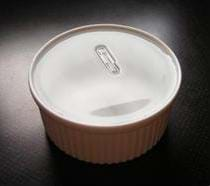
Engineering Connection
Environmental, chemical and civil engineers are all interested in surface tension and surfactants. They study the interactions between surface tension and chemicals as they develop technologies to remove pollutants from our water and air resources. Surface tension also affects many construction materials, so civil engineers consider the surface tension of water when incorporating wooden beams into a building's design. Using water to attach two materials is often convenient, non-corrosive, readily available, transparent, and is easily undone. Engineers also develop technologies for people that are inspired by designs in nature (biomimicry), such as insects that rely on surface tension for survival.
Learning Objectives
After this activity, students should be able to:
- Define and describe surface tension.
- Define and describe a surfactant.
- Describe some uses of surface tension and surfactants by engineers.
Educational Standards
Each TeachEngineering lesson or activity is correlated to one or more K-12 science,
technology, engineering or math (STEM) educational standards.
All 100,000+ K-12 STEM standards covered in TeachEngineering are collected, maintained and packaged by the Achievement Standards Network (ASN),
a project of D2L (www.achievementstandards.org).
In the ASN, standards are hierarchically structured: first by source; e.g., by state; within source by type; e.g., science or mathematics;
within type by subtype, then by grade, etc.
Each TeachEngineering lesson or activity is correlated to one or more K-12 science, technology, engineering or math (STEM) educational standards.
All 100,000+ K-12 STEM standards covered in TeachEngineering are collected, maintained and packaged by the Achievement Standards Network (ASN), a project of D2L (www.achievementstandards.org).
In the ASN, standards are hierarchically structured: first by source; e.g., by state; within source by type; e.g., science or mathematics; within type by subtype, then by grade, etc.
Common Core State Standards - Math
-
Draw a scaled picture graph and a scaled bar graph to represent a data set with several categories. Solve one- and two-step "how many more" and "how many less" problems using information presented in scaled bar graphs.
(Grade
3)
More Details
Do you agree with this alignment?
International Technology and Engineering Educators Association - Technology
-
Explain how various relationships can exist between technology and engineering and other content areas.
(Grades
3 -
5)
More Details
Do you agree with this alignment?
-
Apply the technology and engineering design process.
(Grades
3 -
5)
More Details
Do you agree with this alignment?
Materials List
Each group needs:
- 1 plastic cup or bowl
- 1 paper clip
- 1 square of toilet paper
- a few drops of liquid soap
- paper boat template, one per person, cut from the Surface Tension Boat Template (8 templates on a sheet)
For the entire class to share:
- a sink, small tub or container filled with water (to place the paper boats)
Worksheets and Attachments
Visit [www.teachengineering.org/activities/view/cub_earth_lesson2_activity4] to print or download.Introduction/Motivation
What do you think: Can you get a paper clip to float on water? (Take a class vote: Tally the yes, no and maybe votes, and write them on the board.) How do you think you would do it? Exactly how would you place the paper clip on the water surface? (List all the different suggestions on the board. Possible examples: slowly placing it on top of the water, throwing it in, putting in on a piece of paper, etc.)
(Pass out a blank note card to each student.) If you answered yes, that you think you could float a paper clip, write down your prediction and why you chose it. If you answered no, that you could not float a paper clip, write down your prediction and why you chose it. If you answered maybe, write down your prediction and why you chose it. (After everyone has finished, have a few students share with the class what they wrote.)
Well, an engineer might ask the same types of questions when trying to solve a problem. Asking questions and making predictions is not only part of the scientific process, but also part of the engineering design process as well. Why do you think engineers need to learn about water and what can float on water? There are many reasons! Engineers design technologies to conserve water, to remove contaminants from water (to clean it), to explore under water, and to protect creatures and insects that live in the water.
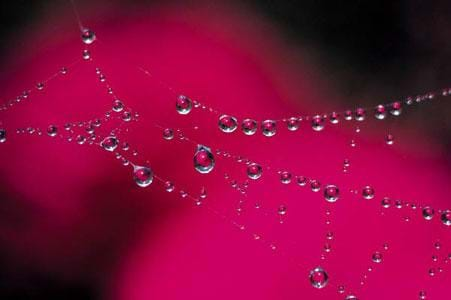
Today we are going to investigate a specific property of water called surface tension, what can change it, and how that property can be useful to engineers. Before I tell you more about surface tension, you are going to do a few experiments to figure it out on your own.
Procedure
Before the Activity
- Gather materials and make copies of the Surface Tension Boat Template.
- Divide the class into teams of three students each.
With the Students
Part 1: Surface Tension
- (optional) Conduct the quick pre-activity demonstration described in the Assessment section. The demo requires wax paper, pennies and water.
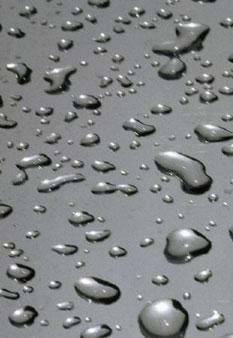
- Tell students that they are going to test all of the methods that were suggested in the activity introduction for how to get a paper clip to "float" on water.
- Ask for student predictions. Who thinks that they will be able to float a paper clip on water?
- Pass out materials to students.
- Have student teams begin testing ways to get the paper clip to "float." Which ways work? Which ways do not work?
- If students cannot get the paper clip to float at all, suggest they place a paper clip on a small piece of toilet paper, and then place it gently on top of the water. The toilet paper should come apart, leaving the paper clip floating on the water.
- After all teams have a floating paper clip (see Figure 1), bring teams back together for a class discussion:
- Who was able to get the paper clip to float on water?
- Which methods worked? Which did not?
- What property does water have that let us do this? (Answer: Surface tension.)
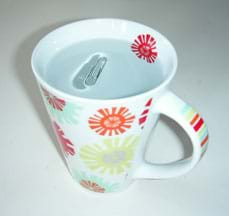
With the Students
Part 2: Breaking Surface Tension
- Tell students that you are going to drop a few droplets of liquid soap into their water before trying to get the paper clip to float again.
- Ask for predictions: With soap added to the water, who thinks it will be harder to float the paper clip? Who thinks it will be easier?
- Drop a few drops of liquid soap into each group's water.
- Have students test all of the ways that worked before to get the paper clip to float on water.
- After all teams tried to float the paper clip, bring them back together for a class discussion:
- Who was able to get the paper clip to float on water? (Expect that fewer students were able to get a paper clip to float than in Part 1.)
- Which methods worked? Which did not?
- What happened? What was the difference? (Answer: Soap made it harder to float the paper clip.)
With the Students
Part 3: Surface Tension/Surfactant-Powered Boats
- Using the attached Surface Tension Boat Template, cut out small paper boats. They should look like and be shaped exactly like those illustrated in Figure 2.
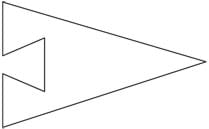
- Place the paper boats into a small tub filled with water. Ask the students: How might we power this boat? How can we propel it from one end of the tub to the other?
- Let's think about surface tension. What happens when we release any kind of tension? Do you think that happens with surface tension? How can we release surface tension? Let's try the soap.
- Have students drop 1-2 droplets of liquid soap into the small triangle cutout at the back of the boat. The boat should propel at least a few inches. Will it work again? Try it? Did it work? (It only works a few times.)
With the Students
Part 4: Post-Activity Discussion and Closure
Why were we able to get a paper clip to float on water? Well, water and other liquids have a property called surface tension. What do the words "surface" and "tension" make you think of? Surface may make you think of the top of the water, where the water meets the air. Tension might remind you of something tight, pulled or strained. Put those together and you have it; water on the surface has a tendency to be tight with the water around it, resulting in a property that pulls it together. This is called surface tension.
So, what happened to the surface tension when we added soap? Well, soap is what we call a surfactant. This word comes from two words: surface and active. (Write these on the board.) Surface, because soap acts on the surface, and active because it acts on the surface. Surfactants act on the surfaces of liquids, in this case water, to reduce surface tension.
What property kept the drops of water together on the wax paper and pennies in the first demo? (Answer: Surface tension. See the pre-activity demo in the Assessment section.) In what situations might a surfactant be useful? (Answer: When trying to remove something floating on the surface of water, like an oil spill.) In what sort of situations might a surfactant not be useful? (Answer: When you are trying to float something on water, like a paper clip.)
In what ways have engineers used the property of surface tension to design things to help people? Engineers understand how surface tension works and use it in many ways. They design printers and printing presses in which surface tension is used in the ink application process. Environmental engineers who clean water and air pollution take advantage of surface tension. They design systems that use the condensation of water, for example, to make drinking water from salty ocean water, or use water vapor to remove pollutants from dirty air. Surface tension determines whether things can float or not, which applies to many everyday situations. Surface tension is a consideration in space flight (zero gravity) — liquids cannot be stored in open containers because they will run up the vessel walls.
In what ways have engineers used surfactants to design things to help us? Engineers figure out ways to use surfactants to break up surface tension. For example, surfactants, like soaps and detergents, break up all kinds of oil, which helps in cleaning up messes. Environmental engineers use surfactants to clean hazardous waste areas or spilled airplane fuel on runways or spilled oil on the surface of the ocean. Chemical engineers design cleaning products using surfactants — everything from laundry soap to shampoo.
How did the surfactant help the little boats move? What happened? (Answer: The surfactant acted to break the surface tension.) Why does it only work once or twice? (Answer: You can only break the surface tension a few of times, and then it stays broken.)
Who knows what a water strider is? (At least one student might know that water striders are insects that "walk" on water using surface tension; see Figure 3.) Do you know what property water striders use to "walk" on water? (Answer: Surface tension.) Engineers at MIT and Carnegie Mellon have developed a mechanical robot water strider that can also "walk" on water (see photo at http://news.bbc.co.uk/2/hi/science/nature/3126299.stm). How might something like this be useful? (Encourage creative ideas.)
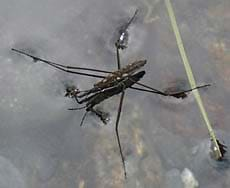
Vocabulary/Definitions
brainstorming: A method of shared problem solving in which all members of a group contribute many ideas.
contaminant: A substance that makes something impure or unclean by contact or mixture.
engineer: A person who uses his/her knowledge of science and math to solve practical problems and create things for the benefit of humanity and our planet.
engineering design process: A decision-making process used by engineers to make something that meets a need or solves a problem. Steps include: brainstorm, design, plan, create, improve.
surface tension: A property of liquids in which water molecules are more attracted to each other than other molecules, causing the water to "stick together."
surfactant: A substance that reduces the surface tension of a liquid in which it is dissolved. For example, soaps and detergents; short for surface-active substance.
water strider: An insect with long slender legs with which it support itself on the surface of water; also called skater.
Assessment
Pre-Activity Assessment
Think About It Demo: Drop a few drops of water on a sheet of wax paper placed on a tabletop. Drop a drop of water on the face of pennies scattered on students' desktops. Ask students to brainstorm with their teammates to come up with ideas about why the drops of water stay together. Why don't they go all over the place? Why do they seem to form spheres? Have students keep these ideas in mind throughout the activity.
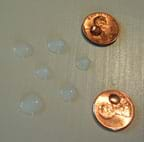
Activity Embedded Assessment
Class Questions: Throughout the activity, ask students the questions embedded at each stage of the Procedure section.
Post-Activity Assessment
Drawing: Have students draw or explain in their own words their answers to these questions: What is surface tension? What does a surfactant do?
Story time!: Have students write a story about a water strider that lives happily in a very clean pond, until — somehow — a surfactant is added to the pond water. Have them include in the story how the water strider lived before, what happened because of the surfactant, from where the surfactant may have come, and what an engineer might do to help the poor water strider.
Activity Extensions
Re-Engineering: Have students redesign their paper boats from Part 3 (of the Procedure section) to travel even further. Test the new designs and keep making improvements.
Penny Challenge: Challenge students to see and record how many drops of water they can put on the face of a penny before the water spills off. As a class, create one bar graph depicting the number of drops each student recorded. This can be done using graph paper where each square can represent 1 or 2 drops of water. What property holds the drops of water together on the penny? (Answer: Surface tension.) What happens if you add a drop of diluted liquid soap? (Answer: The water spills off the penny.)
Subscribe
Get the inside scoop on all things TeachEngineering such as new site features, curriculum updates, video releases, and more by signing up for our newsletter!More Curriculum Like This

Student teams are challenged to evaluate the design of several liquid soaps to answer the question, “Which soap is the best?” Through two simple teacher class demonstrations and the activity investigation, students learn about surface tension and how it is measured, the properties of surfactants (so...

Students learn about the basics of molecules and how they interact with each other. They learn about the idea of polar and non-polar molecules and how they act with other fluids and surfaces. Students acquire a conceptual understanding of surfactant molecules and how they work on a molecular level. ...

Students are presented with the question: "Why does a liquid jet break up into droplets?" and introduced to its importance in inkjet printers. A discussion of cohesive forces and surface tension is included, as well as surface acting agents (surfactants) and their ability to weaken the surface tensi...
References
Castles in the Sand, Water. Out-of-the-Blue Lesson Plans, Curriculum and Activities (grade 3+), Great Sand Dunes National Park and Preserve, National Park Service. Accessed September 18, 2020. https://www.handsontheland.org/grsa/resources/curriculum/elem/lesson35.htm
Dictionary.com. Lexico Publishing Group, LLC. Accessed September 18, 2020. (Source of some vocabulary definitions, with some adaptation) http://www.dictionary.com
Noble, Ivan. Robot Insect Walks on Water. Updated August 6, 2003. BBC News Online Science. Accessed September 18, 2020. http://news.bbc.co.uk/2/hi/science/nature/3126299.stm
Copyright
© 2006 by Regents of the University of ColoradoContributors
Jay Shah; Malinda Schaefer Zarske; Denise W. Carlson; Janet YowellSupporting Program
Integrated Teaching and Learning Program, College of Engineering, University of Colorado BoulderAcknowledgements
The contents of these digital library curricula were developed by the Integrated Teaching and Learning Program under National Science Foundation GK-12 grant no. 0338326. However, these contents do not necessarily represent the policies of the National Science Foundation, and you should not assume endorsement by the federal government.
Last modified: November 4, 2020








User Comments & Tips